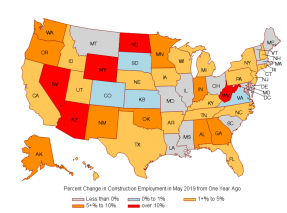This post will look at the states that are seeing increases in homeownership, as well as look at homeownership rates among Black and African Americans, Asian and Pacific Islanders, American Indians, and Whites and Caucasians by state.
Job openings in construction in May 2019 outpaced the number of workers looking for construction jobs.
Eighty-two percent of respondents reported that home prices remained constant or rose in May 2019 compared to levels one year ago (88 percent in May 2018).
At the national level, housing affordability is down slightly from last month but up from a year ago. Mortgage rates were down from last month at 4.30 percent this April, and down 7.7 percent compared to 4.66 percent a year ago.
Home prices are rising at a modest pace, at 3.6 percent nationally as of April 2019. However, the pace of price appreciation varies significantly across metro areas, with highly expensive metros ($700,000 or over) showing price declines and less expensive metro areas, usually with the median list price at $400,000 or below, are showing strong price gains.
Accounting for nearly 17 percent of the GDP, real estate is clearly a major driver of the U.S. economy.
Wages are broadly rising faster than inflation in all industries, except for manufacturing and transportation and warehousing.
There continues to be a price mismatch between homebuyers and sellers, according to REALTORS® who responded to NAR’s April 2019 REALTORS® Confidence Index Survey.
Amid sustained economic expansion and the lowest unemployment rate since 1953, commercial property prices are still broadly trending upwards although at a modest pace compared to past years.
REALTORS® report “low inventory” and “construction” as the major issues affecting transactions in April 2019.
Search Economists' Outlook



























